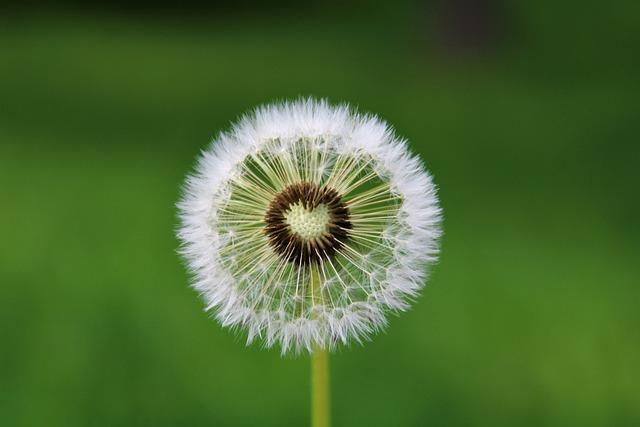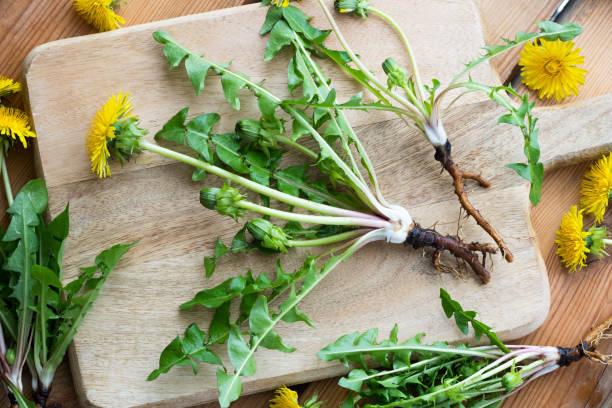Before the cherry season, comes the dandelion season. dandelions. We see them on the roadsides with their serrated leaves and first yellow flowers. with their serrated leaves and first yellow flowers (1,2). another name: lion's teeth, or dandelion in English (2). There are also dandelions in my vegetable bed. I don't weed it, on the contrary.

Young dandelion shoots can be added to salads, soups and vegetable puddings. Dandelion's taste is quite bitter, so we don't use it as a main course, but it's an herb that goes perfectly with many starters!
Traditionally, fresh leaves are combined with mesclun, a salad of young shoots in which lettuce, arugula and spinach shoots are mixed (1).
Dandelion leaves can be blanched like spinach before eating. This softens their taste (3).
Dandelion, an ideal ideal depurative plant for spring?
Nature's way of doing things. Dandelions come out of the ground and bloom in your towns and gardens just when your body most needs a detox (2,3).
This is the main benefit of dandelion dandelion: it detoxifies the body (3). This action is due to its diuretic qualities diuretic qualities: it prevents water retention, as its vernacular name trivial way.
It helps the gall bladder to do its work of elimination. Because of this, herbalists call dandelion a cholagogue as a cholagogue (2,3).
Dandelion also stimulates the action of the liver, your body's your body's great filter. This action is known as choleretic (2,3). Dandelion also aids digestion and has an anti-inflammatory action. Finally, dandelion is also recognized for its anti-rheumatic action(3).
It's a herb that heals, nourishes and cuts hunger. It is recommended for detox cures and even diets, although the latter are not my cup of tea!
In any case, the dandelion is anything but a weed. a weed. And market gardeners have realized this, because today, you can sometimes find them on their stalls.
Is it a nutrient-rich nutrient-rich plant?
The root of the dandelion is deep. This allows the plant to fetch many minerals. So much the better for those who eat it (3)! Dandelion is particularly rich in potassium, the benefits of which are numerous. Potassium helps you to (4) :
- Regulate your heart rate.
- Maintain your body's your body's acid-base balance.
- Synthesize the proteins proteins your body needs.
- Help your muscles recover.
- Keep your kidneys working kidneys.
It's a very important mineral for your body. Dandelion also provides :
- Iron that gives you energy (5).
- Plant calcium, highly assimilable and good for your bones (6).
- Copper for your immune system (7).
- Manganese to help your metabolism run smoothly (8).
- Silica, a structural element for the collagen needed in cartilage and muscle tissue (9).
In short, this beautiful serrated leaf is a concentrate of minerals that play a role in many of your body's processes.
Added to this is a contribution in vitamin C, antioxidant, in vitamin D, good for immunity, and in vitamin K, useful for the cardiovascular system (10).
Note, moreover, that dandelion leaf and root also provide you with inulin, a soluble dietary fiber that nourishes your intestinal bacteria. (11,12,13) .
The dandelion provide you with choline?
This is another characteristic of the dandelion that may make you want to add some to your spring dishes. springtime. Choline is a naturally occurring essential nutrient essential for the liver and brain (12).
It used to be called vitamin B7. But since the body can only produce it in small quantities, it has been removed from the vitamins to a lesser-known category: betaines (12).
Choline helps your body to metabolize fats. It plays a role in the structure of cell membranes and in lipid and lipid transport.
It enables the liver to function optimally. optimally. It helps the liver to process fats, thereby reducing the risk of liver damage. reduces the risk of liver damage. It may also reduce the risk of of diabetes (12).
Finally, choline plays in the functioning of the brain and nervous system. For example, it is very important in the memorization process!
What are the benefits of dandelion root? dandelion root?
I've already mentioned the young dandelion shoots you can add to your salads, but when herbalists think of this exceptional plant, which they call taraxacum officinale, they'll certainly praise its roots (3).
They're also listed in Vidal, the medical dictionary (14). You'll find that dandelion root contains taraxacin, which gives it its scientific name. It's a mixture of bitter substances and inulin (14).
These concentrated substances enhance the medicinal already found in the leaf (14) :
- Choleretic: good for the liver.
- Cholagogue: useful for emptying of the gallbladder.
Dandelion root decoction goes well with detox, difficult digestion, constipation and osteoarthritis. It helps to eliminate toxins, and can therefore improve the complexion (14).

How to use dandelion dandelion for the skin?
You can use the roots to try and dermatosis or skin disease (15). Herbalists believe that dandelion decoction can have can have an effect on eczema, acnepsoriasis and les verrues (15).
With this in mind, you can also mother tincture or even capsules. Fresh roots can also be used as a poultice can also be used as a poultice for the affected area (15).
The medicinal virtues of dandelion then have detoxifying effect on the skin. The poultice becomes like a soothing bandage.
How to make dandelion root coffee?
Dandelion root can also be used as a coffee substitute. substitute for coffee. That said, with "dandelion coffee" you'll get the bitterness the bitterness but not quite the taste...
The advantage of this hot beverage is that it's healthier, more ecological and more economical if you if you make it yourself from roots you've harvested. The disadvantage of this formula is that it requires a little patience and organization.
The best time to harvest the roots is autumn. If you want to make "dandelion coffee you can do so in four stages:
Step 1: harvest the roots and let them dry.
Step 2: brush roots to remove remove the soil. As with mushrooms, brushing prevents them from becoming prevents them from soaking up water when you wash them.
Step 3: cut the roots into slices.
Step 4: heat your oven to 225°C.
Step 5: place the root slices on a baking tray and bake for around 45 minutes. The time also depends on the size of the roots. The thinner they are, the faster they roast.
Step 6: use a coffee grinder to grind the roasted roots.
Step 7: store your ground roots in an airtight container for 12 months.

You can use this coffee substitute in a piston coffee maker, for example.
References
- https://www.perledunord.com/savourons-chaque-jour/les-vertus-secretes-du-pissenlit/
- https://www.passeportsante.net/fr/Solutions/PlantesSupplements/Fiche.aspx?doc=pissenlit_ps
- https://sante.journaldesfemmes.fr/fiches-sante-du-quotidien/2674303-pissenlit-bienfaits-sante-racine-feuilles-mefaits-tisane-foie-danger-infusion/
- https://www.passeportsante.net/fr/Actualites/Dossiers/DossierComplexe.aspx?doc=10-bienfaits-potassium
- https://www.passeportsante.net/fr/Solutions/PlantesSupplements/Fiche.aspx?doc=fer_ps
- https://conseils.eau-vive.com/alimentation/calcium-vegetal-tout-savoir/
- https://alvityl.fr/oligo-elements/cuivre/
- https://alvityl.fr/oligo-elements/manganese/
- https://www.jevaismieuxmerci.com/conseils/silicium-quels-sont-les-bienfaits-de-cet-oligo-element-sur-la-sante-172.html
- https://www.argalys.com/tout-savoir-sur-la-vitamine-k-role-bienfaits-et-carence/
- https://www.laboratoire-lescuyer.com/nos-actifs/choline
- https://www.alloprof.qc.ca/fr/eleves/bv/sciences/la-synthese-des-proteines-s1228
- https://www.aroma-zone.com/info/fiche-technique/actif-cosmetique-inuline-bio-aroma-zone
- https://www.vidal.fr/parapharmacie/phytotherapie-plantes/pissenlit-taraxacum-officinale.html
- https://www.nutrimea.com/fr/56-pissenlit
- https://www.fermelavalsedessaisons.com/caf%C3%A9-de-racines-de-pissenlit-recette-et-utilisation



